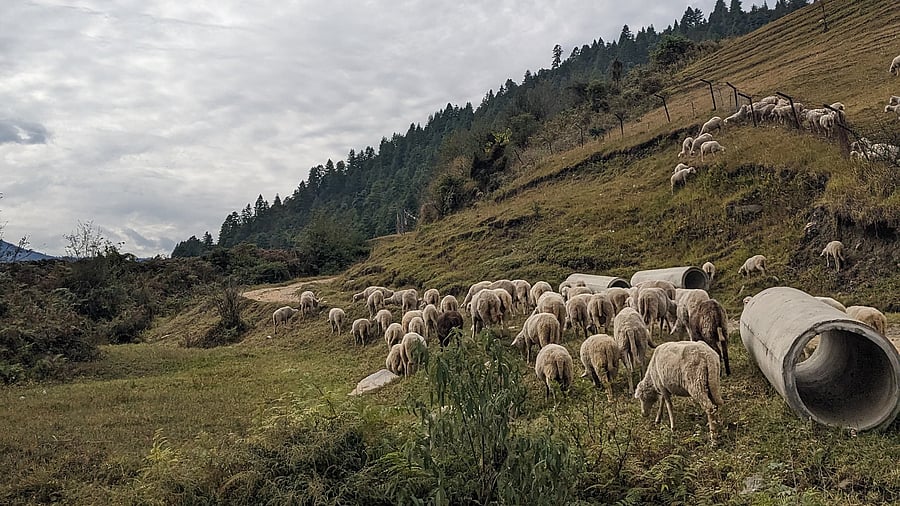
A herd of sheep at the sheep farm in Sangti Valley.
Credit: Special arrangement
Remember in school when we all painted a picture of a river meandering through mountains, surrounded by lush greenery and scattered homes? That was the epitome of an idyllic landscape in our minds. While India is rich in natural treasures, many hill destinations have sadly become over-exploited, contrasting with the serene scenes of our childhood. But Sangti was just that — a picture, a song.
Nestled in the lap of the Eastern Himalayan ranges in Arunachal Pradesh’s West Kameng district, the Sangti Valley offers a postcard-perfect escape. A river winds through it, with towering hills cradling a tiny village dotted with homes. The valley gets its name from the Sangti River, a tributary of the Dirang Chu (with “Chu” meaning river), which converges at Dirang Dzong, a 9th-century village bordering Sangti.
For many, Dirang (a modern settlement, distinct from Dirang Dzong) serves as a stopover on the way to Tawang. The journey to Tawang is long, often taking a whole day, making Dirang or Bomdila (the headquarters of the West Kameng district) ideal resting points. For us, however, Dirang was the destination, and that is how we discovered Sangti.
A narrow road leads to the valley, with an iron bridge marking the boundary from Dirang town. We meandered along the mountainous route beside the Dirang River, passing rows of pine and rhododendron trees until we spotted a beautifully aligned range of black houses. Our driver informed us that we had arrived at the Sangti Sheep Farm. The striking black houses provided a picturesque contrast against the vast expanse of lush green woods. A short walk through apple orchards leads to the farm, where a herd of sheep welcomed us. You could spend time wandering among them and soaking in the scenery. The village lies just a few kilometres ahead.
A sparsely populated village, Sangti feels like a scene crafted by an artist straight from a storybook. Shy giggles from children, curious yet welcoming glances from the elders, and an assembly of neatly arranged wood and stone houses greet you. The valley and the broader Dirang area are primarily inhabited by the Monpa tribe of Arunachal Pradesh, who are of Tibetan Buddhist descent. Colourful religious flags, beautiful gompas (places of worship), and manes (prayer wheels) adorn the region. Everywhere we looked, vertical flags on poles fluttered in the wind, while smaller ones hung between points by strings.
We parked at the village entrance to explore. Curious faces peeked out from the two-storey Monpa houses as we made our way through. While the valley is known for its fertile ground producing apples, kiwis, persimmons, and apricots, only the oranges were in season during our visit in March, just as Spring was beginning. Cherry and plum trees were in full bloom, casting a white and pink glow all around. The rhododendrons were just starting to show their red buds, with a few early blossoms here and there. And there flowed the Sangti River, gently displaying its turquoise waters.
A suspension bridge leads to the banks of the Sangti River. Just across, we found white tents set up by a locally run homestay. With wood piles for bonfires and chickens roaming about, the homestay promised a peaceful retreat where the only sounds to wake you would be the gentle flow of water and birdsong. There were a couple of other village homestays, but no restaurants or eateries at the time. This has changed in recent years, as tourism has flourished, leading to more locally-run homestays across the valley.
Sangti’s heart, much like our villages’ chaurahas, was a beautiful gompa featuring a large prayer wheel. A group of children excitedly guided us as they spun the wheel. Two additional prayer wheels stood outside, accompanied by seating areas. The traditional Monpa homes were crafted from stone, wood, and bamboo, employing minimal modern techniques. Each house had at least one orange tree, its branches heavy with small, sweet oranges. We were warmly offered some. Vibrant flower pots decorated the surroundings, while wooden hangers on the balconies were used to sun-dry meat for storage. A traditional wooden water mill served the village’s washing needs.
Various vantage points are reachable by short treks, providing breathtaking views of the valley. The trekking routes from Sangti lead to lesser-known points and villages that remain largely unexplored by travellers. An iron bridge near the kiwi and maize plantations is known as the Sangti River Viewpoint. As we soaked in the view from there, Sangti seemed to disappear into the grandeur of the towering landscape. My thoughts were interrupted only by the shrieks of children playing by the riverbank, while a few elders fished nearby. The kiwis had just been planted for their harvest season in November-December. Sangti’s maize and kiwis, along with other produce, are highly sought after for their quality, with exports going to neighbouring states, including Assam. Due to its low-lying position between the Himalayan ranges, darkness falls early here, often before 4 pm.
As I reflected, Sangti unfolded like a story, revealed in slow steps and soft sighs.
Life moves with the sun in the river’s embrace, lulled by the pristine surroundings. My walk through the village made me appreciate the essence of simple living. As we returned, a sea of sheep grazed downhill, with the farm standing as a beacon on the other side. Sangti remained, for me, a beautiful postcard.
Best time to visit: Sangti is an all-season destination, with its charm varying throughout the year, except during the peak monsoon.
Connectivity: Dirang is well-connected by road via Assam, with Bhalukpong (134 km from Dirang) serving as the entry point. Shared and private cars operate daily. From Dirang, local cabs are available for sightseeing and trips to Sangti. The nearest airport and railway station are in Tezpur, Assam.